
Story by Matthew Manguso and photos by Joe Mendoza
Editor’s note: This story was originally featured on the cover of the summer 2024 edition of Around the Oval, a benefit of CSU Alumni Association membership.
Deep inside the maze of Moby Arena, Raoul Reiser (Ph.D., ’00), associate professor and director of Colorado State University’s Clinical Biomechanics Laboratory, prepares the computer systems as his graduate students outfit the participating athlete with reflective markers, check the response of the force platform, and ensure the integrity of the artificial turf. The sounds of rubber balls hitting wooden floors echo throughout and serve as a reminder that Reiser’s lab is a reconfigured racquetball court.
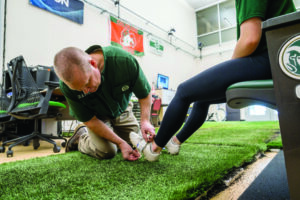 It’s taken about 45 minutes to get everything ready and now, with the high-speed cameras in position, the data-collection systems queued up, and the athlete stretched and ready to go, Reiser gives the signal. Every cut, pivot, jump, juke, and any other maneuver the athlete performs is captured as raw data that is then downloaded and analyzed so the real work can begin. The process is a unique blend of real-world data collection combined with emerging technology.
It’s taken about 45 minutes to get everything ready and now, with the high-speed cameras in position, the data-collection systems queued up, and the athlete stretched and ready to go, Reiser gives the signal. Every cut, pivot, jump, juke, and any other maneuver the athlete performs is captured as raw data that is then downloaded and analyzed so the real work can begin. The process is a unique blend of real-world data collection combined with emerging technology.
As a team of biomechanists, Reiser and his undergraduate and graduate students approach the human body and its movements as a machine with the hope that, by understanding how an athlete interacts with the playing surface, they can maximize athletic performance while reducing injuries.
The body mechanical
Before arriving at CSU to earn his Ph.D. and become a research professor, and before he began thinking about ways he could combine his degrees (a bachelor’s in mechanical engineering from Cornell University and a master’s in kinesiology from the University of Texas at Austin), Reiser was an athlete.
As a football player in college, he was introduced to a new field of study where coaches, trainers, and researchers looked at the human body as if it was a machine. Up to that point, treatments were the focal point of athletic injuries, but proponents of this new field were more interested in understanding why an injury occurred and then trying to understand how those injuries could be prevented.
 “It was then I began understanding how I could improve my own performance while playing football while also helping others to maximize their athletic potential,” he said. “That’s when I stumbled upon someone who called themselves a ‘biomechanist,’ and the idea of applying mechanical engineering to the human body was a natural fit for me. It helped me hone in on what I was missing because I realized I could think about the human body as a machine and apply those concepts to enhance performance.”
“It was then I began understanding how I could improve my own performance while playing football while also helping others to maximize their athletic potential,” he said. “That’s when I stumbled upon someone who called themselves a ‘biomechanist,’ and the idea of applying mechanical engineering to the human body was a natural fit for me. It helped me hone in on what I was missing because I realized I could think about the human body as a machine and apply those concepts to enhance performance.”
Reiser defines biomechanics as the study of how humans move and the forces that are necessary to do that, and his introduction to it was a natural fit. Not only because it was the connecting points between his degrees and interest in athletics, but also because the novelty of the field meant he could take it any direction he wanted. That’s when he decided to accept a role as a research assistant at the Olympic Training Center in Colorado Springs.
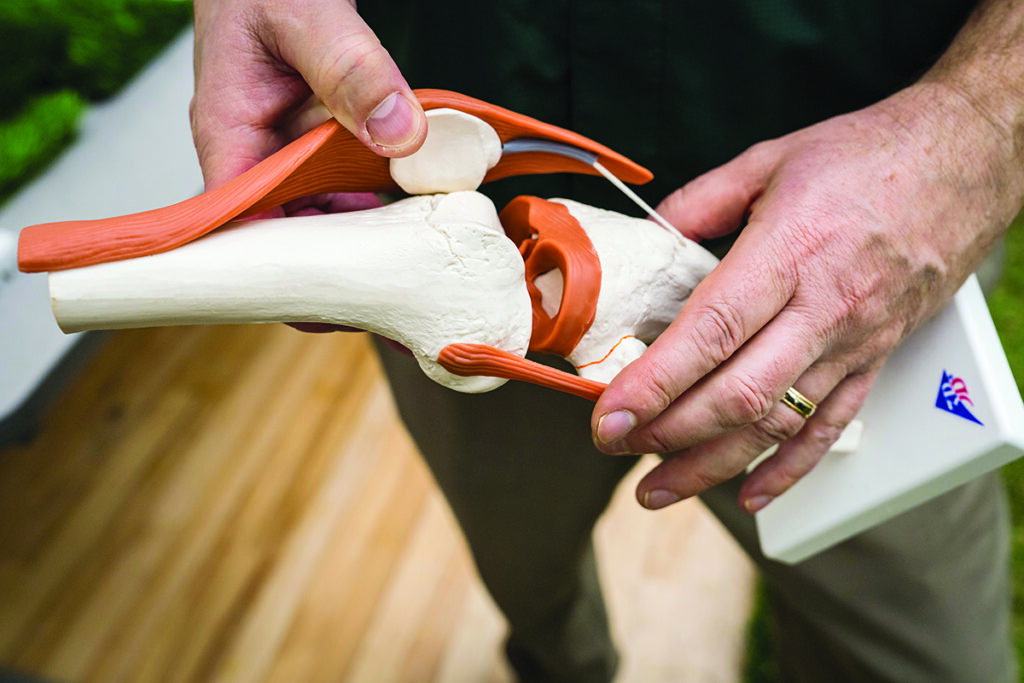
“I did biomechanics work with all sorts of different teams there. A lot of high-speed video work with the figure skating team. Measuring forces, testing balance, and maintaining stability for the archery team that was shooting arrow after arrow,” Reiser explained. “The main team I worked with was the weight lifters because their coach was very interested in how biomechanics could improve weight-lifter success,” Reiser explained.
From there, Reiser had a couple options. He could use his biomechanics skills to help make athletic equipment, such as shoes and sneakers, more responsive to athlete needs, or focus on ergonomics which, as he puts it, is applying biomechanics to the workplace to make desks, chairs, and workstations more user-friendly.
“Every turn I took pushed me to academia,” he said. “I knew of CSU, gave it a look, and found a couple of faculty members who were doing biomechanics work and were willing to take me on as a Ph.D. student.”
Like most people who find their way to Fort Collins and CSU, Reiser fell in love with the University and surrounding town, and each class he took reaffirmed how biomechanics was for him.
“Even if a course wasn’t focused on biomechanics directly, I was able to see how it could be applied to it,” he explained. “If the instructor was discussing an automobile, I realized that’s just a machine, and if I think about the human body as a machine, then I could apply all those concepts to humans.”
Humans were the ideal subjects for Reiser, but being a Ph.D. student meant following the lead of his mentor, mechanical engineering Assistant Professor Mick Peterson, who introduced him to C. Wayne McIlwraith, director of equine sciences and founder of CSU’s Orthopaedic Research Center. That’s when Reiser began applying biomechanics to what he considers to be the greatest athletes in the world – horses.
“[McIlwraith] is an orthopedic surgeon who operated on a lot of racehorses and had always had the question of ‘what role does the track play on horse musculoskeletal injuries’ in the back of his mind,” Reiser said. “He brought me in to help try and understand how racetrack surfaces work with the horses that run on them.”
The experience was enlightening to Reiser, who began seeing just how important the type and quality of a playing surface can be for an athlete, especially when it comes to the many variables that exist on those surfaces. It’s also when he began thinking about what is possible – both in terms of athletic performance and injury prevention – when you have the ability to control a surface.
The green standard
After earning his Ph.D. in mechanical engineering in 2000, Reiser went from student to teacher with his own lab and cohort of graduate students. Five years ago, he began focusing on his current research that seeks to understand how playing surfaces, specifically artificial turfs, interact with an athlete’s performance. It’s a tricky problem to tackle.
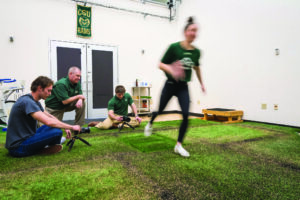 “The research shows us that more musculoskeletal injuries are prevalent on artificial turf than on natural grass. While grass might be the gold standard, there aren’t enough good grass fields for people to play on,” he explained.
“The research shows us that more musculoskeletal injuries are prevalent on artificial turf than on natural grass. While grass might be the gold standard, there aren’t enough good grass fields for people to play on,” he explained.
Acreage, time of year, ecosystem, and how much use a play surface gets are all variables that make coming up with the perfect grass field incredibly difficult to cultivate. And that’s without considering the resources (water, staff, and equipment) needed to keep a grass field in peak shape.
“We know the foot-to-surface interface is playing a role in injuries, and in order to maximize the number of people playing sports and their performance, we need artificial turf to accommodate. It’s about seeing how we can make the best artificial turf possible,” Reiser said.
That’s where Reiser’s lab research comes in.
Where the rubber sole meets the plastic grass
Finding subjects to help conduct research is always a challenge, and Reiser and his team of Ph.D. students have added logistics they need to navigate before they can even begin collecting data.
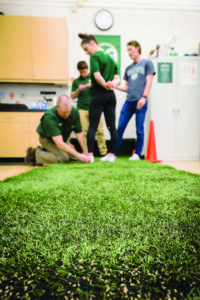 “We try to evaluate a broad spectrum of athletes – soccer, rugby, football, lacrosse, even ultimate Frisbee – to understand the different sport characteristics, but they need to be club level or higher,” Reiser said, adding that the better an athlete, the more practical the data they collect will be. “A problem for us is once you get to that level, the number of athletes starts to dwindle, and if someone is on a varsity team they have a lot of time commitments.”
“We try to evaluate a broad spectrum of athletes – soccer, rugby, football, lacrosse, even ultimate Frisbee – to understand the different sport characteristics, but they need to be club level or higher,” Reiser said, adding that the better an athlete, the more practical the data they collect will be. “A problem for us is once you get to that level, the number of athletes starts to dwindle, and if someone is on a varsity team they have a lot of time commitments.”
When an athlete is willing and able to participate, they can expect to spend about an hour with Reiser and his team making typical movements and motions on various types of artificial turfs (plastic grass) to see how different surfaces affect performance. Everything is tracked, collected, and refined so it can be properly analyzed. And while there are many data points to keep in mind – everything from the athlete’s age, skill, and even shoe – the interaction between that athlete and the turf is the center of attention.
“We’re focused on the surface side of things and how different turfs compare in the way they provide traction and either mitigate or allow forces to prevent an injury,” he explained.
It’s multilayered, he added, because of the four primary companies making artificial turf, each one has about five different types of turf that can be laid on top of 10 different kinds of infills, or what’s beneath the top surface.
“It’s not an easy problem to solve,” he said. “The turf we’re looking at today might not be the same that’s sold in a year because they create a new design. That means we have to think about the bigger picture – what are the main components and how can we manipulate those to our advantage.”
While advances on the industry side can be a hindrance to Reiser’s work, technological updates help Reiser and his team collect real-world data in a more efficient and useful way. The newest piece of technology is an Inertial Measurement Unit, which is part three-dimensional accelerometer gyroscope and part magnetometer. That may sound incredibly futuristic, but most people have one in their pocket.
“If you have a cell phone, you have an IMU,” Reiser said. “It’s the technology that helps switch from landscape to portrait orientation when you’re taking a picture or helps determine your location when using the compass or map feature.”
As IMUs get smarter, smaller, and better, Reiser can take his work from “the restrictive lab” to “a more natural playing field environment” and truly understand how both artificial and natural grasses are affecting injuries and performance.
One step at a time
Even if being confined in the lab can feel outdated for Reiser, to the novice, it feels nothing short of groundbreaking. The reflective markers pick up even the slightest movements of the athlete. When rendered on the screen all you see is a skeleton, which helps the researchers get a bare-bones understanding of how the surface and athlete are interacting. When someone steps on the force plate, it measures where the force is coming from and where it is most strong. Watching a peak athlete in slow motion truly brings the work into focus. But just as game time is only a tiny piece of an athlete’s work, so, too, is the time Reiser and his students spend collecting the data.
“Only 10% of our time is spent with the athlete collecting data. The other 90% involves processing that data to make sure it’s good enough to analyze and making sure all the systems are working correctly. It’s a long pipeline from when the athlete shows up to when we can draw conclusions.”
While there are applications that Reiser can rely on to analyze the data, the team is mostly responsible for writing their own computer programs to properly navigate all the nuances that come with the collection. And Reiser is quick to point out that even though he’s leading the research, it takes an entire team of dedicated graduate students to help it all come together.
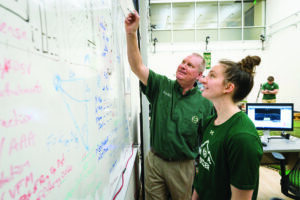 “I love the ability to teach and see the students have that light bulb go off and say, ‘now I get it.’ It’s always exciting to see them have success and then see them move on and be successful in their own way,” he said. “That what I’m trying to do – prepare them to be successful so they can go on to lead the show.”
“I love the ability to teach and see the students have that light bulb go off and say, ‘now I get it.’ It’s always exciting to see them have success and then see them move on and be successful in their own way,” he said. “That what I’m trying to do – prepare them to be successful so they can go on to lead the show.”
The implications for Reiser’s research go deep, especially when you consider that the field of biomechanics began in earnest only in the late 1970s. It’s not just about making professional sports more exciting; it’s about making sports safer and more accessible for all. A superior playing surface will mean that, regardless of the ability to purchase top-of-the-line equipment, athletes from 6 to 60 can confidently step onto a field and play. That’s what keeps Reiser in the lab, sharing his data, and bringing attention to the work.
“The thing that’s super exciting is we’re researching something that will make an immediate difference,” he said. “We’re always going to need to pay attention to that foot-ground interface to maximize player performance while minimizing risk. I like knowing our work will have a direct effect on that.”
The Department of Health and Exercise Science is part of CSU’s College of Health and Human Sciences.